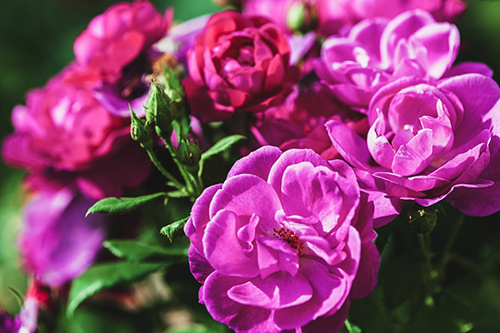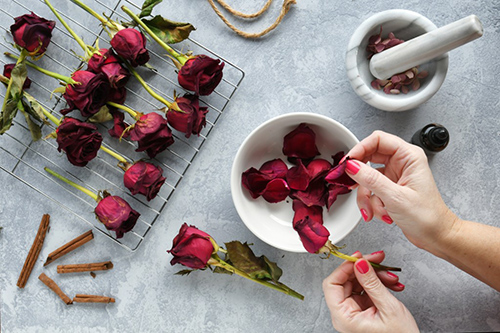Contents
Rose medicinal uses: Flower growers’ fantasy combined with cross-pollination has created 10,000-odd varieties of roses with extraordinary fragrance and delicacy. However, the French rose, or Rosa gallica, offers the best and most health benefits from a medicinal standpoint.

Rose Scientific Facts
- Scientific name – Rosa gallica L.
- French – Rosier.
- Spanish – Rosal.
- Environment – Prevalent in Mediterranean countries, where it usually grows in sunny, calcareous soils. At present, this plant is spread worldwide.
- Description—A shrub of the Rosaceae family, it grows from 0.5 to 1.5 m high, with upright stems with spines and single, big, red, velvet-like flowers.
- Parts of the plant used medicinally – The petals of its flowers.
Rose Medicinal Uses
Rose petals contain a high amount of tannin with astringent properties and anthocyanins, which are responsible for their color and have antiseptic properties, essence, organic acids, wax, and bitter components.
Although some people have celebrated, rose PETALS – possibly due more to a poetic than a scientific meaning – as an almost universal remedy, they have astringent, anti-inflammatory, and antiseptic properties. They also provide soothing properties to the nervous system. Their medicinal applications are the following:

- Gynecological conditions – An infusion of rose petals are used for vaginal irrigations for leukorrhea (an increase of vaginal flow), vaginitis, and cervicitis (inflammation of the uterine neck). It is highly recommended for the hygiene of the external female genitalia, applied as cleansing and irrigation.
- Digestive conditions—Rose petals help stop several kinds of diarrhea, especially summer diarrhea. They have mild astringent properties; however, their antiseptic powers complement them.
- Respiratory afflictions on the upper airways – Both drunk and applied as gargles, mouth rinses, nasal irrigation, infusions of rose petals, and rose water are adequate for nasal catarrh, sinusitis, pharyngitis, and hoarseness.
- Eye conditions—Rose petal infusions are excellent for washing eyes for eye irritation and conjunctivitis, especially for children. They alleviate itching, reduce inflammation of the delicate mucosa on the conjunctiva, and provide good antiseptic properties.
- Psychosomatic conditions – Rose petal infusions calm stress, insomnia, and other nervous disorders related to the genesis of gastro-duodenal ulcers, angina pectoris, bronchial asthma, and irritable bowel syndrome.
- Skincare and beauty – This infusion of rose petals is applied to the skin as lotions and compresses to soothe and cleanse it. Moreover, ROSEWATER invigorates the skin, cleanses the face, and fights acne and wrinkles. Rosewater was successfully used during the Roman Empire 2000 years ago.
Other Healing Roses
Besides the French rose, two species are regarded as medicinal, though their healing properties are less intense.
- The typical rose or rose of Jericho (Rosa centifolia L.), which usually gives pink flowers, is highly desired by perfume-makers.
- Rose of Alexandria (Rosa Damascena Miller) is the most appropriate for obtaining rose water and rose essence.

How to use Rose
- Infusion with 20 to 30 grams of petals per liter of water. Drink from four to six cups daily (sweetened with honey).
- Gargles, mouth rinses, and nose irrigation.
- Eye irrigation.
- Vaginal irrigations.
- Lotions and compresses on the skin.
- Rosewater – It is prepared in laboratories by distilling or dissolving rose essence.
DISCLAIMER: All content on this website is presented solely for educational and informational objectives. Do not rely on the information provided as a replacement for advice, diagnosis, or treatment from a qualified medical expert. If you are pregnant, nursing, or have any preexisting medical concerns, talk to your doctor before using any herbal or natural medicines.
REFERENCES
- George D. Pamplona-Roger, M.D. “Encyclopedia of Medicinal Plants.” George D. Pamplona-Roger, M.D. Encyclopedia of Medicinal Plants. Ed. Francesc X. Gelabert. vols. 2 San Fernando de Henares: Editorial Safeliz, 2000. 635, 636. Print. [rose medicinal uses]
- Botanical/Phytochemical Databases: https://phytochem.nal.usda.gov/phytochem/search
- National Institutes of Health: https://www.nih.gov/
